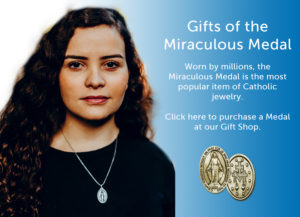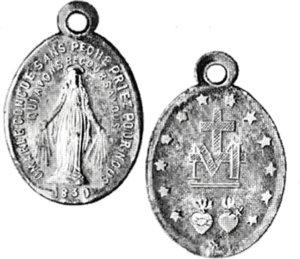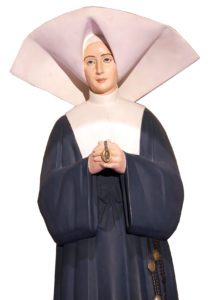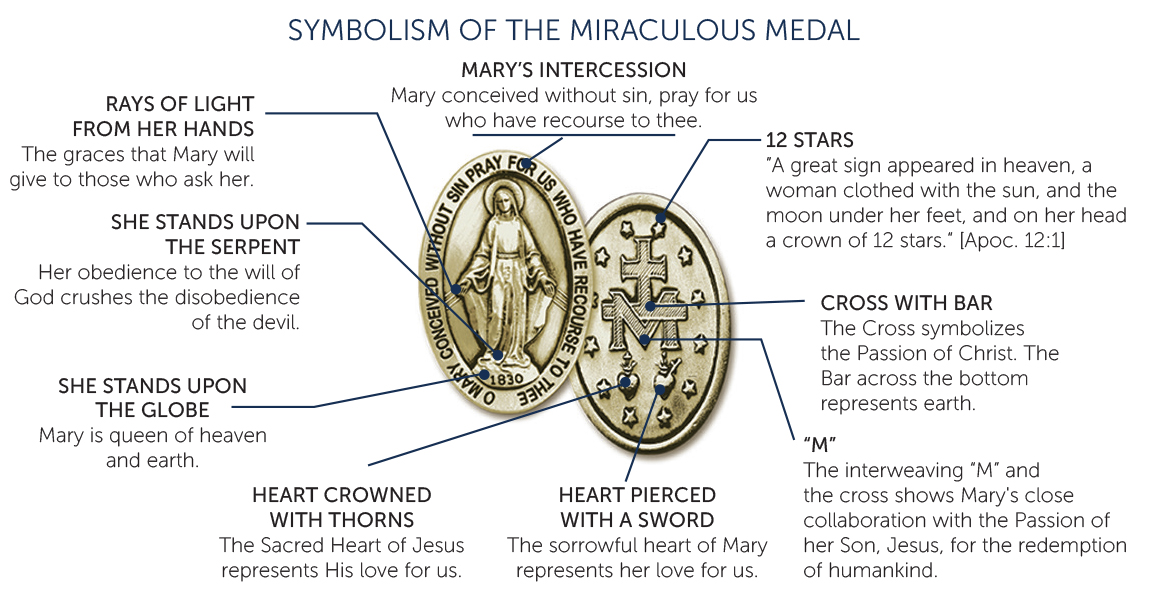A Medal that Changed the World
A Medal that Changed the World
It’s very tiny, barely an inch long and half-inch wide. There’s nothing elaborate or stunning about it. It’s not even made out of silver or gold. How can something so small and simple be such a momentous force in the world? And yet, it is.
Our Catholic Faith is filled with sacramentals that work with, and point to, the spiritual. They are visible reminders of invisible realities. The Miraculous Medal is a powerful reminder, regardless of its size. A pebble thrown into a lake may make some large ripples, but a Miraculous Medal worn with faith and love makes tsunami-size waves.
What makes this Medal so powerful? In one of his Perpetual Novena homilies, Fr. Kieran Moran, CM,1 told the congregation that the power of the Miraculous Medal isn’t based on the material it’s made of, just as the kind of paper a check is written on doesn’t determine the check’s value. The source of the Medal’s power is heavenly: it’s the promise made by our Blessed Mother that has the Church’s blessing and approval.
THE APPARITIONS
 It began on the night of July 18, 1830, when a beautiful child, dressed in white and emanating heavenly light, awakened a young Daughter of Charity novice, Catherine Labouré, from her sleep. She followed him to the Chapel, where all the candles were lit, as if for midnight Mass. After hearing something that sounded like the rustling of a silk dress, Catherine saw a beautiful woman walk in and sit on the chair used by the director of the community. She remarked, “I went closer and, throwing myself on my knees, rested my hands on the knees of the Blessed Virgin. At that instant, I tasted the sweetest joy of my life—a delight beyond expression.”
It began on the night of July 18, 1830, when a beautiful child, dressed in white and emanating heavenly light, awakened a young Daughter of Charity novice, Catherine Labouré, from her sleep. She followed him to the Chapel, where all the candles were lit, as if for midnight Mass. After hearing something that sounded like the rustling of a silk dress, Catherine saw a beautiful woman walk in and sit on the chair used by the director of the community. She remarked, “I went closer and, throwing myself on my knees, rested my hands on the knees of the Blessed Virgin. At that instant, I tasted the sweetest joy of my life—a delight beyond expression.”
The next time Mary appeared on November 27, 1830, she was standing on the world with her feet crushing the head of a serpent,3 with a “globe in her hands. Her eyes were lifted up to Heaven, and her countenance was radiant as she offered the globe to Our Lord.”4 Then, Catherine saw that Mary had rings of precious stones on her fingers. Rays of light beamed from the stones enveloping Mary “in such a dazzling light that I could see neither her feet nor the robe. …It is beyond my power to give an idea of the beauty and magnificence of the rays.”5
During this apparition, Mary told her that the rays symbolize the graces that she bestows to all who ask for them. The stones that shed no light represent the graces that people forget to ask for. Then an oval appeared around the Blessed Mother, with the words “O Mary, conceived without sin, pray for us who have recourse to thee.” Catherine heard the words, “Get a medal struck after this model. Those who wear it when it is blessed will receive great graces, especially if they wear it about the neck. Graces will be abundant for those who have confidence.”6 Then the image turned, and Catherine saw the letter M, intersected at the top with a cross and a bar. Underneath were the hearts of Jesus and Mary with twelve stars surrounding the entire image.
THE MEDALS
When Catherine Labouré told her spiritual director, Fr. Jean-Marie Aladel, CM, about what she had seen and heard, he wanted to take every precaution to ensure that the apparitions were authentic. It wasn’t until he spoke to the Archbishop of Paris and received his approval that Medals were made.7 This task was initially entrusted to Adrien-Jean-Maximilien Vachette, one of the official jewelers of Louis XVIII’s court, in June of 1832. He started by producing two thousand Medals.
 The Daughters of Charity began wearing them and giving them to the elderly and sick. Almost immediately, miraculous healings, cures, and conversions occurred; people began clamoring for the Medal of the Immaculate Conception (as it was originally called). The Medal quickly spread throughout France and then the world. Before long, people were calling it the Miraculous Medal; everyone wanted the Medal that Mary had brought from Heaven.8 Not only did the Archbishop of Paris request some of the first Medals, Pope Gregory XVI put one at the foot of the crucifix on his desk; and the founder of the Sister Servants of the Immaculate Heart of Mary (in the United States) put the image of the Miraculous Medal on his ordination card.9
The Daughters of Charity began wearing them and giving them to the elderly and sick. Almost immediately, miraculous healings, cures, and conversions occurred; people began clamoring for the Medal of the Immaculate Conception (as it was originally called). The Medal quickly spread throughout France and then the world. Before long, people were calling it the Miraculous Medal; everyone wanted the Medal that Mary had brought from Heaven.8 Not only did the Archbishop of Paris request some of the first Medals, Pope Gregory XVI put one at the foot of the crucifix on his desk; and the founder of the Sister Servants of the Immaculate Heart of Mary (in the United States) put the image of the Miraculous Medal on his ordination card.9
The demand for the Medals became so great that between 1832 and 1836, Vachette made more than two million of them.10 There were eleven other engravers in Paris producing Medals, as well.
In 1846, sixteen years after the Miraculous Medal was shown to Catherine, the bishops of the United States unanimously declared Mary Immaculate as patroness of the country. And while Mary’s purity had long been held as a truth of the Church, it had not yet been infallibly proclaimed. The Miraculous Medal helped pave the way for that step by promoting devotion to Mary who was “conceived without sin.”
Indeed, the Medal is a condensed catechism on Mary. On it we see her as the woman who crushes the serpent’s head in Genesis (3:15) and the woman clothed with the sun in Revelation (12:1). We see the Hearts of Jesus and Mary united at the Cross. The wording confirming Mary’s purity circles around her, and the rays from her hands depict her as the dispenser of God’s graces. So it wasn’t a surprise when on December 8, 1854, the dogma of the Immaculate Conception was officially defined by the Church.

THE MOTHER
The Miraculous Medal is a heavenly gift to us from Mary. It’s everyone’s Medal, because she is everyone’s Mother. Moreover, she wants us to wear it with love and trust—not superstitiously like a lucky charm.
It’s a reminder, a tangible sign through which she expresses her Motherly love and desire to help us. We need to wear it as her true children, trying our best to imitate her virtues, to grow deeper in our faith, and to see beyond our own needs and reach out to help the poor, the forgotten, and the lonely.
It’s a reminder that she is always ready to listen, to ease our suffering, to comfort us when we mourn, to heal our souls and bodies, and to rescue us in times of trial. She wants to be our companion, our friend, and our guide. However, all of these things require reciprocation on our part.
And it’s a reminder of her powerful intercession. Mary is not divine nor omnipotent. She is not the author of grace. But she dispenses God’s grace, and, at the same time, her immaculate soul makes her uniquely powerful with God. As Fr. Moran pointed out in his sermons, God sees power differently than we do. To Him, power is measured by the amount of grace in one’s soul. We know that Mary, while on earth, was “full of grace” [Luke 1:28], so her power with God was substantial even then. The Wedding Feast of Cana depicts this beautifully. At His Mother’s four words, “They have no wine,” Jesus willingly changed His future “hour” to the present moment. Now, as Queen of Heaven, Mary has immeasurable power to obtain graces for us. And those graces can be quite formidable.
In a 1962 sermon for the Solemn Novena of Our Lady of the Miraculous Medal, Bishop Francis Furey, Auxiliary Bishop of Philadelphia, says that Mary “wants to protect us from the evils that threaten us. When powerful hostile forces threatened the Church and Western civilization in the l6th century, Pope St. Pius V had recourse to Our Blessed Mother, and Don Juan of Austria led the Christian navies to victory at Lepanto. When, in the 17th century, powerful armies again tried to overcome our Christian civilization, Blessed Innocent XI invoked the aid of Mary, and again the threat was turned back—this time through the victory of John Sobieski, King of Poland, outside the city of Vienna.”
In our own era, nine months after the United States entered World War II, our Blessed Mother was once again called upon to pour her blessings upon the armed forces. Encouraged by the Vincentians of the Eastern Province, pastors organized Mary’s Kneeling Army of Prayer, a movement of people who made the commitment of wearing the Miraculous Medal and praying for peace. At least ten million civilians and members of the military, signed up to be part of this cause and prayed “for the protection of America’s defenders.”13 The Western and Eastern Provinces both heard from men who returned from war and credited Mary and her Miraculous Medal for their safety.
Our Mother and her Medal are, indeed, powerful. We’ve witnessed that countless times at Mary’s Shrine. Therefore, we know the importance of getting her Medal to people in need. Whether sending them to missions in Africa or Panama, or getting them to people in emergencies, we want as many people as possible to know that they are not alone—that they have a tender Mother who is always there to help, comfort, and guide them.
THE CURE
Mary and her Miraculous Medal are just as important today as they were back in 1830. They are the solution to all of the difficulties we’re facing. Now more than ever, we need our Blessed Mother’s comfort and protection. Now more than ever, we need to discover her peace. Now more than ever, we need to know that our Mother is with us. And she is.
In a sermon given in the 1930’s, Fr. Moran told the attendees of the Perpetual Novena that:
“In a certain sense, you were present in that chapel at Paris on that evening when Our Lady appeared. You were present in Mary’s heart because at that time she was thinking of you. …
“Our Blessed Mother asks you to look upon [the Medal] not as an ornament but as a sign that she has fashioned, as a sign that has come out from the great depths of her love for you. This Medal brings to you a message, an assurance not only that she is concerned with everything that worries you, but the Medal brings to you a guarantee that she has for each one of you—saint or sinner, fervent or negligent—that thing which we call love, that thing which we call affection.
“Every time you look upon your Medal, she wants you to remember that when she made her promise to obtain great graces for those who were devoted to her through her Medal, she meant you in particular.”
Let his words sink in: “You were in Mary’s Heart when she appeared to St. Catherine.” Mary remembers her promises and keeps her word. Her Medal, which rests close to your heart, is a reminder of her love for you.
Then come to Mary’s Shrine. It’s her home, filled with her gentle presence. Pour out your troubles to her for all she’s accomplished in your life, for all the graces—big and small—she’s given you. Let her love and peace permeate your soul. Commit yourself to always wear her Medal. And, try to become so much like her that anyone who sees you would say, “You’re just like your Mother.”
Visit the Basilica Shrine of Our Lady of the Miraculous Medal Gift Shop to view a vast selection of Miraculous Medals in every size, style, and price range.


